Despite being the third-smallest state in the U.S., Connecticut is home to 12 unique turtle species! These species are surprisingly diverse, ranging from tiny musk turtles to gigantic snapping turtles and even sea turtles. Let’s take a closer look at all 12 of these fascinating turtles below!
1. Eastern Painted Turtle (Chrysemys picta picta)
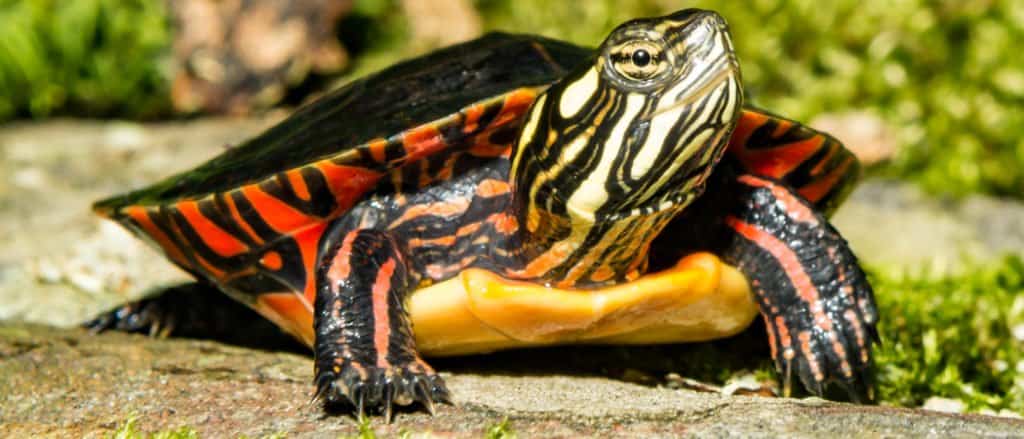
The eastern painted turtle measures around 5 to 9 inches long on average, with males slightly smaller than females.
©Jay Ondreicka/Shutterstock.com
The eastern painted turtle is one of three subspecies of the painted turtle and is Connecticut’s most abundant and widespread turtle!
It measures around 5 to 9 inches long on average, with males slightly smaller than females. It has a somewhat flat, smooth, dark greenish-brown carapace that often has small red markings. The bottom portion of its shell, the plastron, is typically a light orange, while its skin is dark greenish-brown with yellow striping.
This colorful turtle lives throughout the state of Connecticut, and its geographic range covers most of the U.S. east coast. It prefers slow-moving, shallow freshwater habitats like streams, ponds, and marshes with lots of vegetation. It is a highly aquatic species and can also tolerate brackish water.
2. Bog Turtle (Glyptemys muhlenbergii)
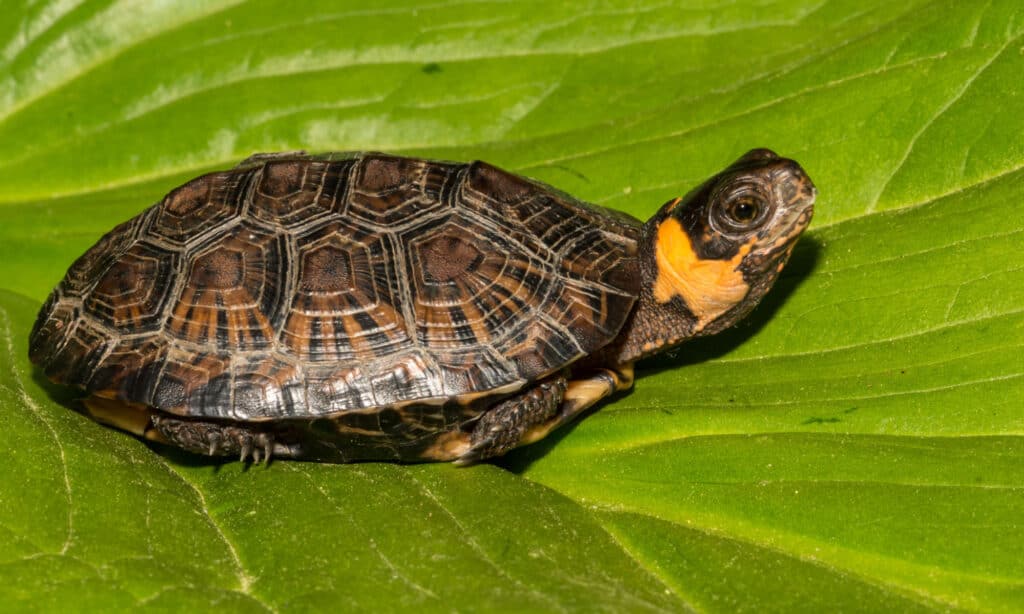
Bog turtles are Connecticut’s rarest turtle.
©Jay Ondreicka/Shutterstock.com
At just 3 to 4 inches long on average, the bog turtle is one of North America’s smallest turtles. It is also Connecticut’s rarest turtle, where it is sadly endangered.
The typical bog turtle has a dark greyish-brown rough, textured carapace with concentric circular markings on each scute. Its skin is mostly dark brown, but it is easy to identify thanks to the bright orange spots on either side of its head along its neck. Its snout is short and rounded in appearance.
Bog turtles live in a fairly limited stretch of land in the northeast U.S. that mainly covers eastern Pennsylvania, most of New Jersey, and southern New York. It also has limited numbers in western Connecticut and can sometimes be found along the Housatonic and Connecticut Rivers. The bog turtle’s preferred habitats are mossy wetlands with lots of aquatic vegetation.
3. Wood Turtle (Glyptemys insculpta)

The wood turtle’s shell is notable for its slightly raised central ridge, known as a keel, stretching lengthwise down its center.
©Jay Ondreicka/Shutterstock.com
The wood turtle is one of Connecticut’s most active and mobile turtles! It moves around 300 feet daily and is speedy enough to hunt its prey on land and water.
On average, wood turtles range from around 5 to 9 inches long. The species gets its name from its rough, textured carapace that is dark brown and has a wooden, sculpted appearance. Its shell is also notable for its slightly raised central ridge, known as a keel, stretching lengthwise down its center. Its plastron is yellow with dark brown patches, while its skin is mostly dark brown with a dark orange or yellowish throat and chin area.
This turtle’s geographic range covers most northeastern United States, from northern Virginia to northern Maine and even parts of southern Canada! It also lives as far west as the Great Lakes area. Its preferred habitats are slow-moving bodies of freshwater like streams and ponds with muddy or sandy bottoms.
4. Spotted Turtle (Clemmys guttata)
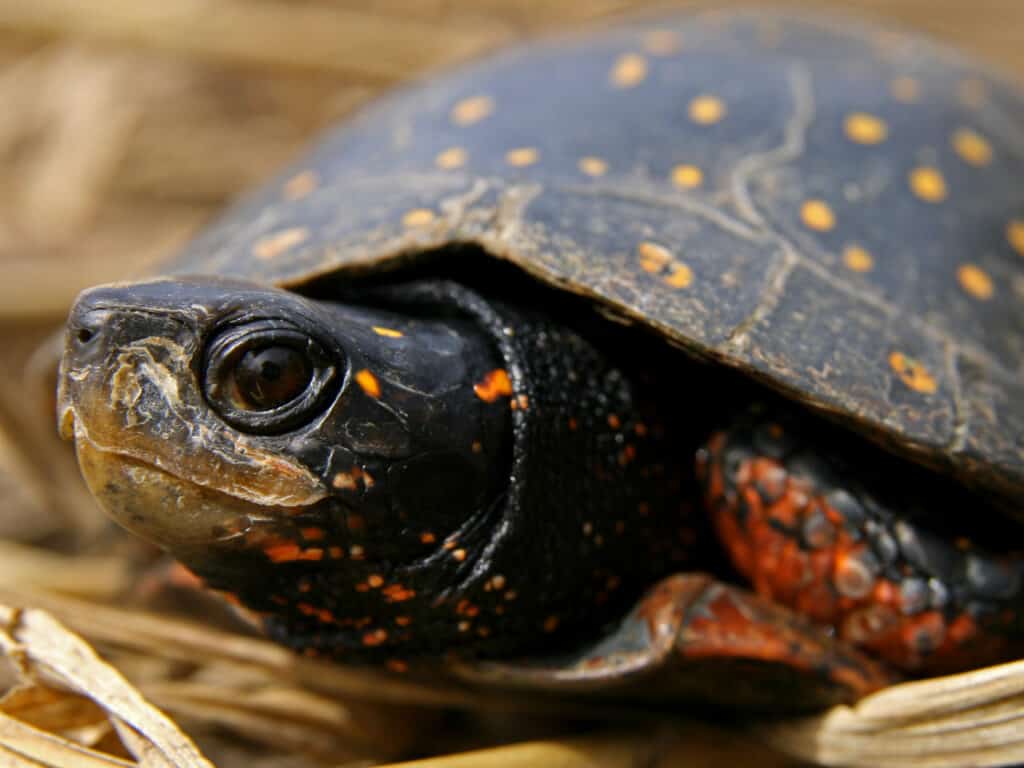
True to its name, the spotted turtle’s carapace is dark brown and covered in tiny bright yellow spots.
©Ryan M. Bolton/Shutterstock.com
The spotted turtle is unique for its tendency only to hunt and feed underwater! It is a skilled hunter and often eats small invertebrates like worms, slugs, and snails.
True to its name, the spotted turtle’s carapace is dark brown and covered in tiny bright yellow spots. Its skin is also dark brown and often has irregular yellow or orange splotches around the head, neck, and limbs. It averages 3.5 to 5 inches in length and has a somewhat flat, oval-shaped shell. Males have darker faces and longer, thicker tails than females.
The spotted turtle’s geographic range covers most of the coastal eastern United States from northern Florida up through southern Maine. It also lives in the Great Lakes area and parts of southern Canada. In Connecticut, it mainly resides in slow-moving freshwater habitats with soft, muddy bottoms and lots of aquatic vegetation.
5. Green Sea Turtle (Chelonia mydas)

Turtles use cloacal respiration as an addition to respiration with their lungs.
©iStock.com/Greg Sullavan
Although they usually stick to warm, subtropical waters, green sea turtles often migrate through Connecticut’s coastal waters in the summer months! They rely on the sun to navigate between feeding areas and nesting spots and feed almost solely on seagrass and jellyfish.
These massive turtles vary in size, usually from 3.5 to 4 feet long, but they can reach as long as 5 feet! Despite their colorful name (which comes from the turtle’s greenish body fat underneath its shell), green sea turtles have mostly reddish-brown carapaces and yellowish or off-white plastrons. Their skin is a creamy, off-white shade with lots of reddish-brown spot-like markings. They weigh a whopping 250 to 450 pounds, and males have longer, thicker tails than females.
These gentle giants nest along the eastern U.S. coast from May through August each year. No green sea turtles have been documented on Connecticut’s actual shores. However, they pass through the state’s coastal waters yearly.
6. Common Musk Turtle (Sternotherus odoratus)

As a highly aquatic species, common musk turtles prefer slow-moving freshwater habitats and lots of aquatic vegetation.
©Mike Wilhelm/Shutterstock.com
Though it is quite small, the common musk turtle has a powerful defense mechanism! It is often referred to as the “stinkpot turtle” due to its ability to emit a foul-smelling substance from the scent glands along the sides of its shell.
On average, this little turtle is roughly 3 to 5 inches long. It has a tall, dome-shaped dark brown carapace often covered in algae. Its neck is very long for its small size. Its skin is dark brown or black with thin yellow stripes along the sides of its head and neck.
As a highly aquatic species, common musk turtles prefer slow-moving freshwater habitats like streams and ponds with muddy or sandy bottoms and lots of aquatic vegetation. The species’ geographic range covers most of the eastern half of the U.S., and it also lives throughout the state of Connecticut.
7. Loggerhead Sea Turtle (Caretta caretta)
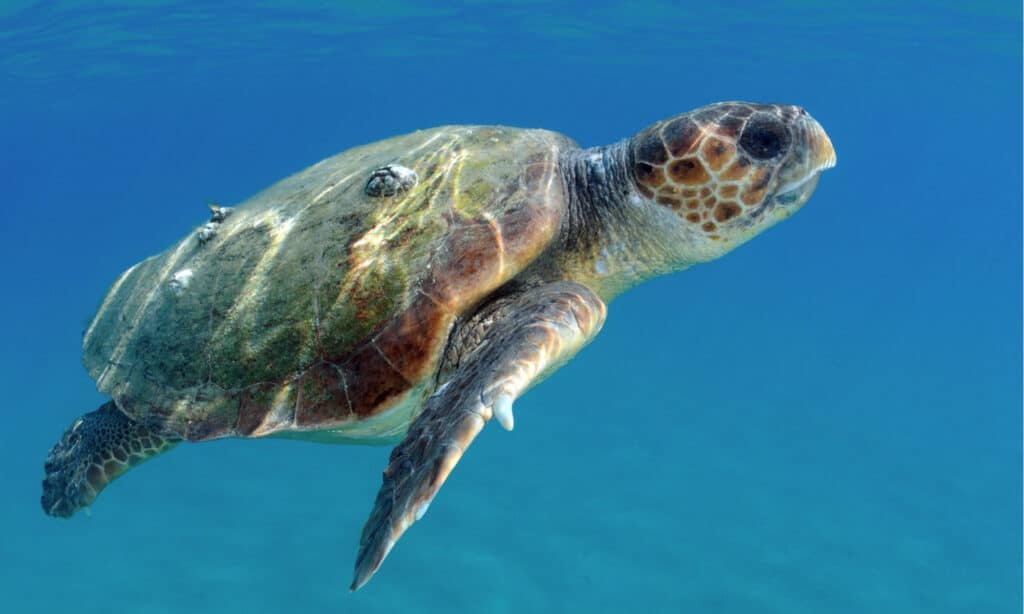
Named for its large, triangular head and powerful jaws, the average loggerhead sea turtle ranges from 250 to 450 pounds.
©Matteo photos/Shutterstock.com
Despite having the widest geographic range of all sea turtle species, the loggerhead sea turtle is very rare in Connecticut. However, many individuals occasionally pass through the state’s coastal waters off the Long Island area.
Named for its large, triangular head and powerful jaws, the average loggerhead sea turtle ranges from 250 to 450 pounds. It usually reaches 30 to 40 inches (or roughly 3 feet) long. It has a reddish-brown teardrop-shaped carapace and off-white skin with many compact reddish-brown spots.
Incredibly, the loggerhead is the world’s largest hard-shelled turtle! It’s also one of the largest turtles in general, just behind the leatherback and comparable to the green sea turtle in size.
8. Common Snapping Turtle (Chelydra serpentina)
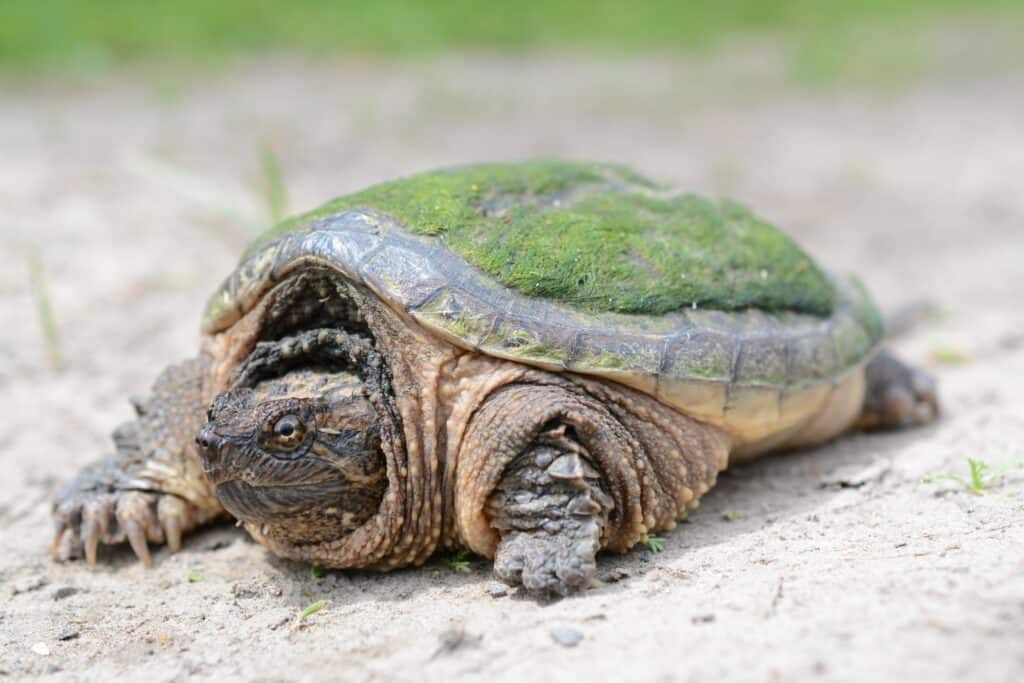
As one of the largest freshwater turtles, the common snapper averages 12 to 20 inches in length and weighs 30 to 40 pounds.
©Trevor Meunier/Shutterstock.com
The common snapping turtle is hardy enough to live just about anywhere in the United States! It’s also quite widespread in Connecticut. This is partly due to its few natural predators and its ability to thrive in many habitats.
As one of the largest freshwater turtles, the common snapper is substantial in length and weight. It averages 12 to 20 inches long and weighs 30 to 40 pounds. However, especially large individuals can reach over 80 pounds in rare cases! This prehistoric-looking reptile has a wide head and an extremely long neck for its size, and its rugged, textured carapace is often covered in a thick layer of algae. Its limbs are bulky, powerful, and surprisingly flexible, thanks to its small plastron that gives its legs extra mobility.
This tough turtle’s geographic range covers most of the U.S. Midwest and the country’s eastern half. It lives as far north as southern Canada and south as southern Florida and tolerates a wide range of freshwater and brackish habitats. In Connecticut, snapping turtles live throughout the entire state.
9. Kemp’s Ridley Sea Turtle (Lepidochelys kempii)
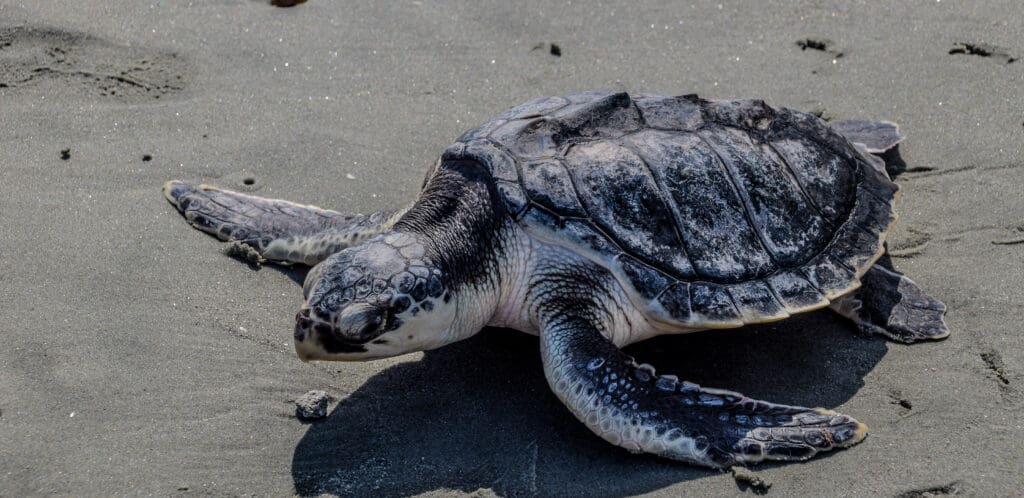
Although it is the smallest of all sea turtles, the Kemp’s Ridley averages 70 to 100 pounds and 20 to 28 inches in length.
©Prentiss Findlay/Shutterstock.com
The Kemp’s Ridley sea turtle is unique for several reasons. For starters, it’s the smallest sea turtle in the world. It’s also the rarest and most endangered sea turtle, though it is the most abundant sea turtle along New York’s shores.
Although it is the smallest of all sea turtles, the Kemp’s Ridley is still quite substantial in size at 70 to 100 pounds and 20 to 28 inches long on average. It has a brownish-green carapace with a yellowish or off-white underside and plastron. Its skin is a pale greyish or off-white, creamy tone, often accented by clusters of small greyish-brown spots on its head and the tops of its limbs. Juvenile turtles of the species are dark purple but lighten significantly in color as they age.
This rare sea turtle’s geographic range is fairly limited, as it mainly lives and nests in the Gulf of Mexico. However, juveniles often swim along the eastern U.S. coast and rarely pass through Connecticut’s coastal waters in the warmer summer months.
10. Eastern Box Turtle (Terrapene carolina carolina)
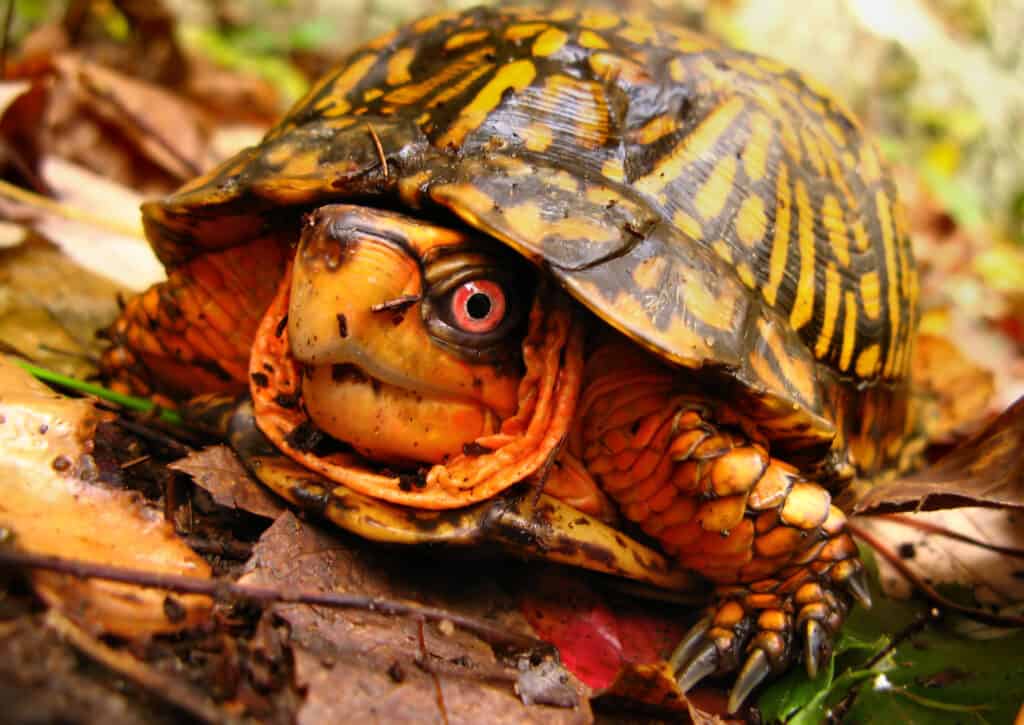
As its name implies, the eastern box turtle lives throughout the eastern United States, including most of Connecticut.
©outdoorsports44/Shutterstock.com
The eastern box turtle is one of Connecticut’s most abundant turtles. This is partly because they’re incredibly hardy little reptiles thanks to their double-hinged shell that can regenerate and heal damage over time.
On average, the typical eastern box turtle is just 4 to 6 inches long. It has a tall, dome-shaped carapace and a plastron with hinges. The turtle can use these hinges to completely “box” or close itself into its protective shell. Its skin and shell vary wildly in color, but both are usually brown with yellow, orange, or reddish markings throughout. Interestingly, males of the species have reddish eyes, while females’ eyes are dark brown.
As its name implies, the eastern box turtle lives throughout the eastern United States, including most of Connecticut. It prefers forested habitats near small bodies of freshwater. Surprisingly, these turtles have very limited home ranges and often spend their entire lives in just a 2 to 5-acre area. During the cooler months, they hibernate by burrowing into surrounding soil and vegetation.
11. Leatherback Sea Turtle (Dermochelys coriacea)

Leatherback sea turtles can easily be identified by their smooth, greyish-black shells that have 7 long ridges or keels.
©Stephanie Rousseau/Shutterstock.com
As the largest non-crocodilian reptile and the largest turtle species in the world, the leatherback sea turtle is absolutely massive! Its name comes from its leathery skin and soft, scuteless shell.
Leatherback sea turtles typically reach 5 to 6 feet long and weigh anywhere from 500 to 1,000 pounds. They can easily be identified by their smooth, greyish-black shells that have 7 long ridges or keels, stretching down them lengthwise. Similarly, their skin is dark grey to almost black, and they have long, strong flippers to navigate strong ocean currents.
Leatherbacks have the widest range of all sea turtle species by far. It lives throughout the Atlantic, Pacific, Indian Oceans, and the Mediterranean Sea, and individuals often pass by Connecticut’s shores in the summer months.
12. Northern Diamondback Terrapin (Malaclemys terrapin)

Northern diamondback terrapins range from 4 to 6 inches in length.
©Jay Ondreicka/Shutterstock.com
Finally, we come to Connecticut’s last resident turtle species, the northern diamondback terrapin. Notably, it is the only North American turtle that spends most of its life in brackish water rather than freshwater or saltwater.
Typically, northern diamondback terrapins range from 4 to 6 inches in length. Their carapaces are dark brown with darker, concentric circular patterning on each scute. They have pale greyish skin with lots of tiny black spots and splotches. The species’ webbed feet are quite large for their size.
Due to its preference for brackish coastal habitats like estuaries and salt marshes, the diamondback terrapin mainly lives along the U.S. northeast coast from Virginia up through Maine. It also lives along Connecticut’s eastern coast.
Up Next:
The photo featured at the top of this post is © Stephanie Rousseau/Shutterstock.com
Thank you for reading! Have some feedback for us? Contact the AZ Animals editorial team.






